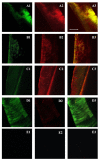Confocal Laser Scanner Evaluation of Bactericidal Effect of Chitosan Nanodroplets Loaded with Benzalkonium Chloride
- PMID: 35329976
- PMCID: PMC8950515
- DOI: 10.3390/jcm11061650
Confocal Laser Scanner Evaluation of Bactericidal Effect of Chitosan Nanodroplets Loaded with Benzalkonium Chloride
Abstract
The aim was to evaluate the antibacterial efficacy and penetration depth into dentinal tubules of a solution of chitosan nanodroplets (NDs) loaded with Benzalkonium Chloride (BAK). Seventy-two human single-root teeth with fully formed apex were used. Cylindrical root dentin blocks were longitudinally sectioned and enlarged to a size of a Gates Glidden drill #4. After sterilization, root canals were infected with Enterococcus faecalis ATCC 29212 and further incubated for three weeks. Specimens were assigned to three experimental groups (n = 20), plus positive (n = 6) and negative (n = 6) controls. In the first group, irrigation was achieved with 2 mL of NDs solution loaded with BAK (NDs-BAK), in the second with 2 mL of 5% sodium hypochlorite (NaOCl) and in the last with 2 mL of 2% chlorhexidine (CHX). Specimens were rinsed and vertically fractured. Confocal laser scanning microscopy (CLSM) and viability staining were used to analyze the proportions of dead and live bacteria quantitatively. The volume ratio of red fluorescence (dead) was calculated in 3D reconstructions. Data were analyzed by one-way ANOVA and post hoc Bonferroni tests (p < 0.05). The ratio of red fluorescence over the whole green/red fluorescence resulted in a significant comparison of NDs-BAK with NaOCl (p < 0.01) and NaOCl with CHX (p < 0.01). No differences were found between NDs-BAK and CHX (p > 0.05). The mean depth of efficacy was, respectively: NDs-BAK 325.25 μm, NaOCl 273.36 μm and CHX 246.78 μm with no statistical differences between groups. The NaOCl solution showed the highest antimicrobial efficacy, but nanodroplets with BAK seemed to have the same effect as CHX with a high depth of efficacy.
Keywords: benzalkonium chloride; chlorhexidine; confocal laser microscope; nanodroplets; sodium hypochlorite; viability staining.
Conflict of interest statement
The authors affirm that any conflict of interest is disclosed.
Figures

Similar articles
-
Effect of a Benzalkonium Chloride Surfactant-Sodium Hypochlorite Combination on Elimination of Enterococcus faecalis.J Endod. 2016 Jan;42(1):145-9. doi: 10.1016/j.joen.2015.08.035. Epub 2015 Nov 11. J Endod. 2016. PMID: 26577873
-
Antibiofilm activity of ultrasonic and diode laser activated sodium hypochlorite, chitosan, and chlorhexidine: A confocal laser scanning microscopic in vitro study.J Conserv Dent Endod. 2023 Jul-Aug;26(4):441-446. doi: 10.4103/jcd.jcd_224_23. Epub 2023 Jul 28. J Conserv Dent Endod. 2023. PMID: 37705555 Free PMC article.
-
Effect of smear layer against disinfection protocols on Enterococcus faecalis-infected dentin.J Endod. 2013 Nov;39(11):1395-400. doi: 10.1016/j.joen.2013.05.007. Epub 2013 Aug 31. J Endod. 2013. PMID: 24139261
-
The effect of detergents on the antibacterial activity of disinfecting solutions in dentin.J Endod. 2012 Jul;38(7):948-53. doi: 10.1016/j.joen.2012.03.007. Epub 2012 Apr 24. J Endod. 2012. PMID: 22703659
-
Antibacterial Efficacy of Pastes Against E Faecalis in Primary Root Dentin: A Confocal Microscope Study.J Clin Pediatr Dent. 2015 Spring;39(3):247-54. doi: 10.17796/1053-4628-39.3.247. J Clin Pediatr Dent. 2015. PMID: 26208070
Cited by
-
An Oxymetazoline-Based Nasal Solution Removes Bacteria-Blood Debris on Dental Surfaces and Has Antimicrobial Activity Toward Streptococcus mutans.Int J Mol Sci. 2025 Jan 31;26(3):1242. doi: 10.3390/ijms26031242. Int J Mol Sci. 2025. PMID: 39941008 Free PMC article.
-
The use of oxymetazoline-based nasal solutions to remove bacteria-blood debris and eradicate Rothia dentocariosa: an artificial cavity model study.BMC Oral Health. 2025 Mar 27;25(1):448. doi: 10.1186/s12903-025-05791-z. BMC Oral Health. 2025. PMID: 40148918 Free PMC article.
-
Antimicrobial efficacy of chitosan versus sodium hypochlorite: A systematic review and meta-analysis.Oral Dis. 2024 Nov;30(8):5445-5460. doi: 10.1111/odi.15099. Epub 2024 Aug 9. Oral Dis. 2024. PMID: 39119693 Free PMC article.
-
Special Issue "The State of the Art in Endodontics".J Clin Med. 2022 Apr 22;11(9):2329. doi: 10.3390/jcm11092329. J Clin Med. 2022. PMID: 35566459 Free PMC article.
-
Antibacterial efficacy of quaternary ammonium compounds (QACs) against Enterococcus faecalis in endodontic infections: a systematic review and meta-analysis.BMC Oral Health. 2025 Aug 7;25(1):1301. doi: 10.1186/s12903-025-06573-3. BMC Oral Health. 2025. PMID: 40775318 Free PMC article.
References
-
- Eriksen H.M., Kirkevang L., Petersson K. Endodontic epidemiology and treatment outcome: General considerations. Endod. Top. 2002;2:1–9. doi: 10.1034/j.1601-1546.2002.20101.x. - DOI
-
- Alovisi M., Pasqualini D., Scotti N., Carpegna G., Comba A., Bernardi M., Tutino F., Dioguardi M., Berutti E. Micro-CT evaluation of rotary and reciprocating glide path and shaping systems outcomes in maxillary molar curved canals. Odontology. 2021;110:54–61. doi: 10.1007/s10266-021-00631-2. - DOI - PMC - PubMed
LinkOut - more resources
Full Text Sources
Molecular Biology Databases
Miscellaneous

